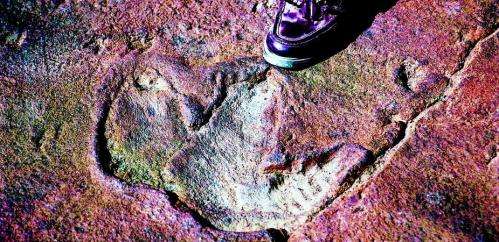It's time to stop the fossil trade in its tracks – and here's how

Collecting fossils helps raise interest in palaeontology and the natural history of Australia, and many important fossil discoveries have been made by members of the public collecting unusual specimens and bringing them to museums for identification.
In fact, Australia's most famous dinosaur Muttaburrasaurus was discovered in this way, when a grazier sent bones to the Queensland Museum for identification.
But overzealous collecting can seriously hinder or even ruin ongoing research by removing specimens and damaging site stratigraphy (the geological layers that define ages of specimens).
So how can we keep these sites safe?
Unfortunately there are many documented cases of fossil theft from important sites. A quick internet or eBay search reveals the prevalence of the fossil trade driving many of these concerns.
The 1996 theft of a fossilised Stegosaurus trackway from near Broome, Western Australia, highlights the scale of the problem. The theft would have involved heavy machinery working in difficult conditions, and the specimen is likely to have been collected to order.
The importance of these prints is that Stegosaurus is otherwise unknown in Australia – which also makes the prints invaluable to scientists as a huge extension of the range of this species. To fossil traders though, this rarity drives up price in a lucrative but obscure industry, at times linked to organised crime.
Current legislation
Federally there are no laws regarding collecting fossils, though a permit system controls the export of fossils and restricts significant specimens leaving the country.
Legislation governing collection of fossils is left to the states and varies considerably across jurisdictions. In general, most states restrict collection in parks administered by a state body (such as National Parks and Wildlife Service).
Some important fossil localities have been protected by having reserves created for their preservation. Some states have fossil localities covered by "heritage places" or similar, providing extended protection.
But policing of these laws is limited, particularly as most sites are quite remote. It's only when fossils are seized at export that authorities attempt to trace their collection.
Important fossil localities form only a small part of larger parks. This means restricting collection may also limit exploration of these areas. This could deter collectors from bringing unusual or rare fossils to the notice of palaeontologists in museums and universities, for fear of prosecution.
At sites where fossils are numerous and of little interest to researchers, freely allowing collection encourages the study of natural history and palaeontology.
Current legislation doesn't prevent overzealous exploitation of fossil localities on private or Crown land. Often slabs of fossiliferous rocks are removed and sold, either as individual specimens or as solid pieces of decorative rock.
The greatest threat to many sites occur as a by-product of some other activity, such as that proposed industrial development of James Price Point in Western Australia.
With competing concerns and a lack of clear legislation, the problem is how to best manage fossil sites in a way that does not unnecessarily stifle research, industry and tourism.
Protecting the future of the past
The PaleoParks initiative, started in 1996, aims to provide technical information to managers, legislators and collectors to assist in managing this important resource.
Launched and overseen by the International Palaeontological Association (IPA) in the US, the project is establishing an international online catalogue of scientific, historic and tourist attributes of each site.
These localities are assessed by researchers to determine the level of protection required. The IPA then works with legislators to provide protection appropriate for each site.
The outcome is a searchable database of localities showing which sites allow collection and information on access, as well as relevant educational materials.
For land managers, PaleoParks provides information on the best practises for conserving sites, as well as placing sites in a global context to help understand their value.
For researchers it provides a means for ongoing research to feed directly into management, protecting sites if there is sufficient cause to do so.
Importantly this concept does not require modification of existing land use arrangements, with PaleoParks being equally applicable to private, Crown and park land.
It is also ongoing, so changes in management, site use and ongoing research can be fed continually into the process. It does not change existing laws, but as changes in legislation are considered, PaleoParks should provide a simpler means to evaluate the palaeontological resource, assess risks they face and determine the best way to control access in the future.
At the end of the day it's a question of who decides. Fossils don't and shouldn't really belong to any single group (except in South Australia where for some reason they are the property of the Crown).
The question is how to manage their protection when there are competing interests at stake.
Provided by The Conversation
This story is published courtesy of The Conversation (under Creative Commons-Attribution/No derivatives).
![]()



















